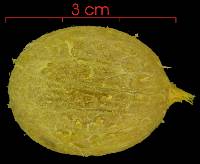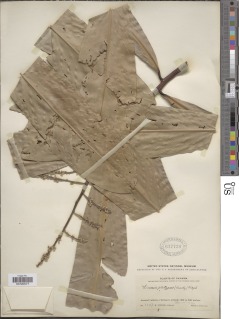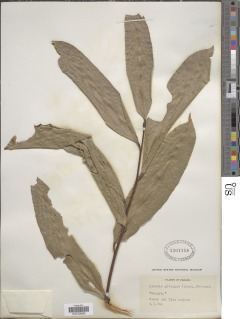

|
|
|
|
Family: Chrysobalanaceae
sangre, more...sapote, tuqueso
|
Description: A moderately large forest tree with a straight cylindrical trunk. Large trees have small buttresses at the base. The bark is down, with lenticels; inner bark (visible if slashed with a knife) is red. The leaves are simple, alternate, very long and narrow, with straight sides; new leaves are red. The petiole is short and slightly thickened. Where the leaf margin meats the petiole, there is usually a small, dark gland. Stipules are in pairs, but they readily fall and are usually not seen except where new leaves are emerging. Reproduction: Flowers are at the end of branches, but are small, greenish-white, and inconspicuous. They mature between February and July. The fruit is a large, spherical, berry, greenish-brown then yellow, with lenticels. Fruits mature from June to August. Distribution: Only known in the area from mature forest at Barro Colorado and Soberania, where it is not very common. Similar Species: The long, narrow, alternate leaves are reasonably distinctive, but this species could be confused with some Annonaceae (like LK unonpi Unonopsis pittieri LK2 at Barro Colorado) or Lauraceae (like LK ocotde Ocotea dendrodaphne LK2 at Soberania). Chrysobalanaceae is generally a difficult family; see LK marapa Maranthes panamensis LK2 for a discussion. Descripción: Árbol de 15 a 30 m de alto. Copa redondeada y con follaje lustroso. Tronco con raíces tablares de mediano tamaño en la base. Corteza exterior marrón y lenticelada, internamente es roja. Ramitas terminales cilíndricas y con lenticelas blancas. Hojas simples y alternas, de 10-35 x 3-9 cm, oblongas o lanceoladas, con ápice acuminado, bordes enteros a ondulados y base redondeada. Las hojas jóvenes son de color rojizo y presentan un par de glándulas en la base. Estípulas deciduas. Pecíolo de 0.8-1.5 cm de largo. Flores blancas o verdosas, aromáticas. Frutos en drupas elipsoidales, de 4-15 cm de largo, verdes o marrón, tornándose amarillentos al madurar. Datos Ecológicos: La especie crece a bajas elevaciones, en bosques húmedos o muy húmedos. En Panamá se encuentra en las provincias de Bocas del Toro, Chiriquí, Darién, Los Santos, Panamá y Veraguas. Crece asociada a las pendientes y hondonadas dentro del bosque maduro de la isla de Barro Colorado. A veces es cultivado en fincas y huertos caseros. Florece y fructifica entre febrero y agosto. Las flores son visitadas por abejas y otros insectos. Las semillas son dispersadas por animales, principalmente murciélagos que se alimentan de la pulpa de los frutos. Especies Parecidas: A menudo se confunde con plantas de la familia Lauraceae, pero las Lauraceae no tienen estípulas. Por el parecido de los frutos se puede confundir con plantas del género Pouteria (Sapotaceae), pero Pouteria tiene savia lechosa. Usos: La pulpa de los frutos maduros es comestible y de sabor dulce. La madera es empleada en construcciones rurales. El árbol se cultiva como frutal, ornamental y para sombra. Sangre, Wild pear, Zapote Tree' 10-30 (50) m tall; trunk to 75 cm dbh (sometimes buttressed to 1-2.5 m elsewhere); branches and leaves glabrous; branchlets often reddish; sap red in age. Petioles ca 1 cm long; stipules ovate, ca 2.5 mm long, stiff, adnate to petiole at base, persistent; blades mostly narrowly oblong-elliptic, shortly acuminate at apex, acute to rounded at base, 10-20 (30) cm long, 3-6 (8) cm wide, lustrous above, pale and +/- glaucous below, with small round flattened or sunken glands below, especially near margin. Panicles terminal or upper-axillary, 10-25 (35) cm long, the branches gray-tomentose, flattened at base; flowers minute, white, fragrant, sessile or very short-pedicellate; hypanthium, sepals, and edges of petals gray-tomentose; hypanthium +/- turbinate, ca 1.5-2 mm diam; sepals 5, triangular, ca 1 mm long and wide, spreading; petals 5, obovate, 2-3 mm long; stamens 15, glabrous; filaments ca 3 mm long, attached separately to disk; style 5-6 mm long. Drupes variable in size, reported to 20 cm long and 14 cm diam, green turning brown; mesocarp granular, yellow, juicy, sweet; seed usually 1, ovate-oblong, flattened, to 5 cm or more long. Croat 8695, 11851. Southern Mexico (both coasts) south to Colombia; reported also from the valley of the Magdalena (Jimenez S.,1970). In Panama, known from tropical moist forest in the Canal Zone, Chiriqui, Panama, and Darien; Allen (unpublished) reported the species to be very common on the dry Pacific coast, and Johnston (1949) reported that it appears to prefer growing on well-drained terraces in ravines. |









































